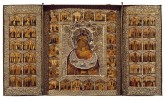The Mother of God Tenderness of Vladimir, with Feast Days and Saints
Triptych. Moscow. Early 17th century setting and painting
- Wood, средник и створки на цельных досках с двумя встречными шпонками, pavoloka, tempera, оклад:, silver, gilding, chasing, stones:, emeralds, garnets, turquoise, topaz, pearls. 40.1 x 70.2 x 4.6 (opened); 39.9 x 16.5 x 2 (volets); 39.9 x 33.6 x 2 (centre)
- ДРЖ-2559
Пост. в 1917 из собрания М. С. Олива-
Сведения о реставрации:
Реставрирован в Москве Г. И. Чириковым (1913)
The painting of the triptych icon and its setting relates to a number of leading works of the early seventeenth century. The triptych was executed by the royal icon-painter Procopius Chirin in Moscow, probably at the commission of Nikita Stroganov, for whom he often painted icons. Its fine silver setting seems to have been manufactured there at the exact same time, judging by the exact correspondence between the pictorial representations in the central and side sections and the apertures in the setting. The figured icon-cases are resolved in the shape of arches with laminated ends and are decorated with a floral ornamental design on a kantharene background. The background features a miniature rosette with trefoils leading away from it on slender bending stems. There are also spiral-shaped shoots and trefoils in the margins.
The tsata and the double nimbus with its high crown are set in pearls and adorned with stones in castes and on the points of the crown. The central representation of the Mother of God is similarly framed with pearls. Three embossed plates with Greek letters are affixed to the background. Russian Museum: From Icons to the Modern Times. Palace Editions, St Petersburg, 2015. P. 62.

